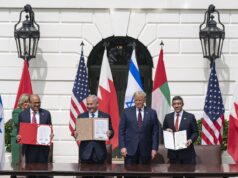The Arab countries have experienced rapid changes in their economic fortunes in the last year. During the first half of 2008, oil, natural gas, and other commodity prices continued to rise rapidly, leading to huge gains. At the same time, they had to cope with rapidly rising food and raw material prices that threatened their economies and social stability. By July, the effects of the financial crisis and expectations of much lower global growth caused a collapse in oil prices. As a result, Arab oil exporters experienced a fall in hydrocarbon receipts, deterioration in their terms of trade, and declining surpluses on their balance of payments.
Between July and December, the Organization of the Petroleum Exporting Countries (OPEC) basket price of oil fell by 70 percent from a peak of just over $130 per barrel to under $40 per barrel. In September 2008, with the collapse of Lehman Brothers and the turmoil on Wall Street, stock markets all over the world fell, including those in the Middle East.
Arab banks were not overly exposed to the U.S. mortgage or derivatives markets, but sovereign wealth funds and other holders of equities suffered large losses. The stock markets in the region suffered along with others around the world. In the twelve-month period ending in February 2009, the Saudi stock market fell by 49 percent, Dubai’s by 72 percent, and Egypt’s by 61 percent. These losses have reduced consumption and discouraged investment.
Oil Producers
What did this all mean for Arab countries? The answer depends on the extent to which they were oil producers.
In April 2009, oil prices stabilized at about $50 per barrel, despite falling demand and much pessimism about the short-term prospects for the international economy. The main reason for this was that oil had become a store of value for those who lost confidence in the dollar and other currencies. There remains, however, extreme uncertainty about the state of the international economy and the short term as well as longer-term prospects for oil prices.
The oil-rich states have predictably, since August 2008, experienced a sharp decline. According to the U.S. government’s Energy Information Agency, oil income for Arab members of OPEC will continue to fall from $678 billion in 2008 to $268 billion in 2009. Saudi Arabia’s export revenues are forecast to decline from $285 billion to $111 billion and Iraq’s from $59 billion to $23 billion. While forecasts must be treated with caution, these estimates seem reasonable.
This will have a direct impact on the economies of the larger oil producers. For example, the Saudi budget is expected to go into deficit—possibly as high as 11-12 percent of GDP —for the first time since 2002. Economic growth has decelerated from about 4 percent in 2008 to almost zero in 2009. In the UAE, the large budget surplus recorded in 2008 will give way to a deficit in 2009. Economic growth has fallen sharply from nearly 8 percent in 2008 to under one percent.
Currently, high government expenditures are filling the void left by the retrenchment of private sector activity in oil-producing states. This is the case, for example, in Kuwait, Libya, and Saudi Arabia.
Non-Oil Producers
The International Monetary Fund (IMF) warns that a protracted period of global economic turmoil could prompt oil exporters to reassess their long-term oil price expectations and thus curtail infrastructure spending plans and investment in oil production, which are already low. This would have negative effects on the economy of the entire region because the demand for Arab workers in the oil-rich states would fall with consequent effect on their remittances. Inter-Arab tourism revenues would decline, resulting in less investment by the richer Arab states in the poorer ones. This, in turn, could lead to lower asset prices, which would feed through to corporate and, eventually, bank balance sheets, placing even greater stress on financial institutions in the region.
All of the Arab countries experienced rising food prices as well as increases in other costs in the first half of 2008, which badly hit the poor. Consumer prices in Egypt, Jordan, and in other countries rose by an annual rate of 25 percent or more during the early months of the year. Food prices rose even faster. The poor had no financial reserves to fall back on, resulting in riots in Egypt, with tensions rising elsewhere as well.
Governments in the non-oil producing states or those with small production were not well-placed to help. What assistance they could extend resulted in larger budget deficits. In Syria, for example, the budget deficit officially planned for 2009 is now $5.3 billion, equal to about 9.25 percent of forecast GDP.
In the second half of 2008, Egypt suffered a 35 percent fall in Suez Canal revenues as a result of the slowdown in international trade. Tourism revenues have also fallen; this will reduce GDP growth by several percent. As a result of the crisis, Egypt has delayed increasing energy prices, designed to cut the subsidy bill that reached $15 billion in June 2008. The government is wary of anything that raises prices after the 18 percent increase in 2008. As of early 2009, inflation is forecast at about 8 percent. Economic growth has decelerated and is expected to be about 4 percent compared with 7 percent in 2008.
In Jordan, tourism and other service incomes have fallen along with domestic consumer confidence. The government’s fiscal stance is strongly expansionary. This will support the economy given the weakness of the private sector. Still, economic growth is forecast at 3.5 percent in 2009, falling from 5.8 percent in 2008.
In North Africa, Morocco’s government increased spending on social projects to mitigate the effects of the global financial crisis. In 2008, thanks to subsidies, inflation was kept at an officially-estimated rate of about 4 percent. However, even that rate provoked unrest and demand for wage raises. Despite government measures, unemployment has increased and is forecast to exceed 10 percent in 2009, while GDP growth is expected to slow to less than 3 percent from more than 5 percent in 2008.
Local real estate and equity markets have come under intense pressure across the Arab world. Domestic liquidity conditions have worsened, credit spreads have soared for some firms, and financial systems have come under pressure. Meanwhile, the market for Arab exports in Europe, the United States, and the Gulf has shrunk. The substantial decline in external demand has reduced export growth, workers’ remittances, and tourism revenues. These pressures have particularly affected Egypt, Jordan, Morocco, and Lebanon.
Broadly speaking, the Arab countries will experience slower economic growth, weaker balances of payments, and higher unemployment in 2009. And because the economic crisis has hammered the global economy, international aid will not flow freely. The U.N. Conference on Trade and Development (UNCAD) reports that direct foreign investment in West Asia fell from $50 billion in 2006 to under $12 billion in 2007. The year 2008 is likely to have been even weaker. We should expect more of the same in 2009.
However, the most important challenge facing these Arab countries is reducing unemployment. The slowdown in economic growth that is now being experienced is expected, according to most forecasts, to last at least a year, and will reduce the level of employment. Greater socio-economic and even political pressures in the region can therefore be expected. This is a factor that may contribute to continued instability in many Arab states.
Positive Notes
This is not to say that the Arab states will be decimated by the global recession. The International Monetary Fund (IMF) has forecast that in 2009 economic growth in the Middle East will be 2.5 percent compared to 6 percent in 2008. While this may sound ominous, it is actually better than some of the developed economies that have sunk into negative growth. As in the Asian crisis of 1997, the Arab world has been less affected by the international financial crisis than other regions of the world. This is the case because, with the exception of the oil sector, the Arab world is much less integrated into the international economy than most other regions.
The Arab states are not significant exporters of non-oil products, so they are less exposed to the contraction of world trade. In 2007, Arab states accounted for about 20 percent of world fuel and mining exports, but only about one percent of world exports of manufactured goods. This meant that, in sum, Arab states accounted for less than five percent of total world exports. Normally, this would be a depressing statistic; it is a silver lining during a worldwide recession.
It is also worth noting that central banks across the region have reacted appropriately, providing liquidity, cutting reserve requirements, and lowering interest rates. This is the case in Egypt, Jordan, Kuwait, Saudi Arabia, and the UAE. Countries with pegged exchange rates (such as Bahrain, Kuwait, Libya, Oman, Qatar, Saudi Arabia, Syria, and the UAE) have benefited from the continued monetary easing in the United States.
In countries that have been most affected by financial sector pressures, tighter liquidity, falling property values, and rocky stock markets, the policy responses have been relatively swift. Authorities have implemented myriad measures to shore up confidence and prevent a systemic banking crisis. These have included introducing blanket deposit insurance (Kuwait and UAE), providing liquidity, and injecting capital into banks (Qatar, Saudi Arabia, and UAE).
Economic Reform?
Another silver lining is that many of the aforementioned oil producers have sought to invest wisely with the surplus cash they earned in recent years. This was particularly true of Saudi Arabia. Budget surpluses enabled it in recent years to reduce internal debt.
It also resulted in an accumulation of foreign assets (admittedly, some of this was lost in the crash). The Saudis, along with other states, have concentrated on infrastructure projects and helping the private sector take a larger role in developing the non-oil and gas sectors. Abu Dhabi, the richest oil-producing member of the UAE, had $875 billion in investment funds at the beginning of 2008; Kuwait’s Reserve Fund for Future Generations had $250 billion. Even Libya had accumulated $50 billion in its Oil Reserve Fund.
If the crisis encourages Arab governments to restructure their economies, they will be better placed when the international economy picks up. Saudi Arabia and some other Gulf States are taking these challenges much more seriously than in the past. They are investing large sums in upstream hydrocarbon projects to get more value from their oil, and are trying to diversify their economies away from petroleum products. They have also made investments in alternative energy to reduce domestic demand for oil and gas, thus freeing up more for export.
On the other hand, the fact that oil-producing states have not been affected as much as others may induce complacency. This could, in turn, lead to a failure to enact meaningful economic reform at this critical juncture, and only ensure similar problems in the future global downturns that are sure to follow.
Paul Rivlin is a senior Research Fellow at the Moshe Dayan Center for Middle Eastern and African Studies at Tel Aviv University. He is the author, most recently, of Arab Economies in the Twenty-First Century (Cambridge University Press, 2009).




